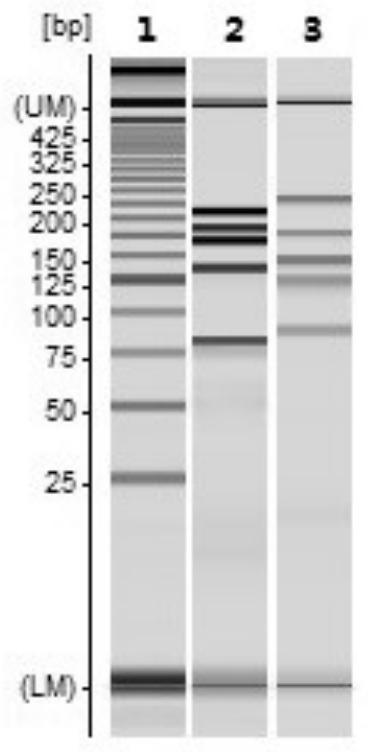A combination of primers for the simultaneous detection of 14 animal-derived components in meat or meat products and its application
A technology of animal-derived components and primer combinations, which is applied in recombinant DNA technology, biochemical equipment and methods, and microbial determination/inspection, etc., can solve the problems of single-plex PCR detection of few species, limited popularization and application, and low detection efficiency. , to achieve the effect of strengthening meat market supervision, improving detection efficiency, and accurate inspection results
- Summary
- Abstract
- Description
- Claims
- Application Information
AI Technical Summary
Problems solved by technology
Method used
Image
Examples
Embodiment 1
[0068] Embodiment 1 5 heavy PCR reaction systems and detection results of the present invention
[0069] 1. Sample processing method
[0070] Weigh 25 mg of 14 common meat samples of pig, cow, sheep, goat, chicken, duck, dog, fox, raccoon dog, deer, cat, mouse, horse, and donkey into centrifuge tubes.
[0071] 2. DNA extraction method
[0072] Use DNeasy Animal Tissue DNA Extraction Kit to extract the DNA of each species, operate according to the kit instructions, or other recognized extraction methods with the same efficacy. The extracted DNA was measured with a fluorescent microplate reader at 260nm and 280nm absorbance, and the DNA concentration and purity were calculated.
[0073] 3. Primer sequence
[0074] A reaction well:
[0075] Specific primers required for amplification of bovine components are:
[0076] Bovine F: 5'-GTTCTTCACGACACATACTACGTT-3' (SEQ ID NO.1)
[0077] Bovine R: 5'-GCAAATACAGCTCCTATTGATAAA-3' (SEQ ID NO.2)
[0078] Specific primers required for...
Embodiment 2
[0114] Embodiment 2 The specificity of 10 pairs of primer systems of 5 times PCR of the present invention
[0115] 1. Template preparation method
[0116] Referring to the DNA extraction method in Example 1, the DNA of 16 species of pigs, cattle, sheep, goats, chickens, ducks, dogs, foxes, raccoon dogs, cats, mice, donkeys, deer, horses, fish, and mink were extracted respectively, and calculated DNA concentration and purity. Dilute the DNA samples of 16 species to 1ng / μL for later use.
[0117] 2. 5-fold PCR reaction
[0118] 2.1A reaction well
[0119] With reference to the 5-fold PCR reaction in Example 1, the mixed primers in reaction well A were mixed with pigs, cattle, sheep, goats, chickens, ducks, dogs, foxes, raccoon dogs, cats, mice, donkeys, deer, horses, fish, and mink respectively. 16 templates were amplified.
[0120] 2.2B reaction well
[0121] With reference to the 5-fold PCR reaction in Example 1, the mixed primers in reaction wells B were mixed with pigs...
Embodiment 3
[0124] Example 3 The detection limit of the method for identifying animal-derived components in meat according to the present invention
[0125] 1. Template preparation method
[0126] 1.1A reaction well
[0127] Referring to the DNA extraction method in Example 1, cow, donkey, fox, deer, and horse DNA were mixed in equal proportions as the initial template, and the concentration of each component was 1 ng / μL, and then the initial template was diluted 10 times to 10 -3 ,spare. The amount of template added was 2 μL.
[0128] 1.2B reaction well
[0129] Referring to the DNA extraction method in Example 1, cat, pig, mouse, sheep, and duck DNA were mixed in equal proportions as the initial template, and the concentration of each component was 1 ng / μL, and then the initial template was diluted 10 times to 10 -3 ,spare. The amount of template added was 2 μL.
[0130] 2. 5-fold PCR reaction
[0131] The reaction was carried out with reference to the 5-fold PCR system in Exampl...
PUM
 Login to View More
Login to View More Abstract
Description
Claims
Application Information
 Login to View More
Login to View More - R&D
- Intellectual Property
- Life Sciences
- Materials
- Tech Scout
- Unparalleled Data Quality
- Higher Quality Content
- 60% Fewer Hallucinations
Browse by: Latest US Patents, China's latest patents, Technical Efficacy Thesaurus, Application Domain, Technology Topic, Popular Technical Reports.
© 2025 PatSnap. All rights reserved.Legal|Privacy policy|Modern Slavery Act Transparency Statement|Sitemap|About US| Contact US: help@patsnap.com



